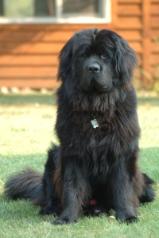
This is a placeholder text
Group text
by Ibrahim on 08 November 2014 - 20:11
In a breeding program, which is easier to improve out of these elements ?
1. Steep Shoulder Angle
2. Short Front Upper Arm
3. Poor Shoulder Blade Lay
4. Soft Pasterns
5. Splayed untight Feet
6. Loose Hocks, Cow Hocks
7. Short Croup
8. Steep Croup
In other words which of the above do you think have dominant or recessive genes ?
And which of them do you think are inter connected, meaning they either improve together or worsen together ?
Thanks
Ibrahim
by susie on 08 November 2014 - 20:11
Difficult question -
out of personal experience I think #1, #2, and#3 go together, so do #4 and #5.
We are trying to better #1-3 for decades now, not much progress, same problems with #7 and #8.
I might be wrong, but I think hindquarter overangulation is combined with #4 and #5 at some point ( #6 for sure ).
Might be like a complex technical construction, everything has to work together, in the end you need to find the golden middle, not the best in one part.
Just thoughts...
by vk4gsd on 08 November 2014 - 21:11
not a breeder so just guessing, this is biology not physics, to think you can change one "component" without affecting every other component at the same time in mostly unpredictable and most likely unwanted ways is naïve at best and imo is the key fallacy and breed destroyer that most "educated" breeders fail to grasp.
breeders might like to think they can play god but evidently few have the qualifications.
breed for performance in the work and the rest will follow.
not the answer you wanted.
by rtdmmcintyre on 08 November 2014 - 21:11
vk if you breed only for performance you will see a faster and more significant changes in the breed there will become so much change it won't even appear to be the same breed in 20 years. To breed for particular physical structures isn't any more playing God then is breeding for work.
by Ibrahim on 08 November 2014 - 21:11
vk, yes it wasn't exactly what I asked for, but you have a point when you say
this is biology not physics, to think you can change one "component" without affecting every other component at the same time in mostly unpredictable and most likely unwanted ways is naïve at best and imo is the key fallacy and breed destroyer that most "educated" breeders fail to grasp.
I would agree more if that was " few other". But I am open to all opinions and will learn something from each one of them
by vk4gsd on 08 November 2014 - 21:11
"vk if you breed only for performance you will see a faster and more significant changes in the breed there will become so much change it won't even appear to be the same breed in 20 years."
compared to the breed 20 years ago and 20 years before that......?
anyhoo, i agree so lets get to it.
best breeding phillosohy i have heard in a while, thanks rd.
by ILMD on 11 November 2014 - 22:11
from my experience, the loose hocks and bad pasterns can be improved in one generation. Shoulders and croups always seem to be a work in progress, even when correct ones are bred And to be honest how many times do you see a dog with a really nice shoulder and a long correct croup. It's very diffulcult to start with poor shoulders and breed your way out of it.
by SitasMom on 12 November 2014 - 04:11
Croup is easier to improve than shoulder/forearm/withers......more bones in front assemble, than rear assembly.
by gsdstudent on 12 November 2014 - 16:11
I attended the UScA general board mtg last week. Karen MacI gave a nice and informative presentation about that groups Breed program. She complimented the working dog lines for improvement in conformation. She stated she was ''bucking'', a little, the SV's overly long lower leg [ i do not like ''over angulated'' as a term, as the beast is either correct in angulation or incorrect] and the problem of dogs getting too big. When asked if I like conformation, i answer ''yes''. Conformation is what carries the dog to its job. Gravity is constant. A correct dog can fight gravity and run for a longer time.
by Ibrahim on 12 November 2014 - 16:11
That is really interesting
Contact information Disclaimer Privacy Statement Copyright Information Terms of Service Cookie policy ↑ Back to top





